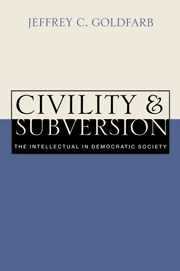Book contents
- Frontmatter
- Contents
- Acknowledgments
- 1 Introduction: the intellectuals at century's end
- 2 Who are the intellectuals?
- 3 The civil intellectual and the public
- 4 The subversive intellectual and the public
- 5 The civil society ideal
- 6 The intellectuals and the politics of culture after communism
- 7 The university
- 8 Race and discursive disruption
- 9 Race and sustained deliberation
- 10 Why is there no feminism after communism?
- 11 Civility and subversion in cynical times
- Notes
- Bibliography
- Index
9 - Race and sustained deliberation
Published online by Cambridge University Press: 06 July 2010
- Frontmatter
- Contents
- Acknowledgments
- 1 Introduction: the intellectuals at century's end
- 2 Who are the intellectuals?
- 3 The civil intellectual and the public
- 4 The subversive intellectual and the public
- 5 The civil society ideal
- 6 The intellectuals and the politics of culture after communism
- 7 The university
- 8 Race and discursive disruption
- 9 Race and sustained deliberation
- 10 Why is there no feminism after communism?
- 11 Civility and subversion in cynical times
- Notes
- Bibliography
- Index
Summary
Thurgood Marshall did all he could to remain on the Supreme Court beyond the years of the Reagan and Bush administrations. His last great battle was against his very mortality. He desperately wanted to outlast the Republican reaction, to reserve his seat for a like-minded jurist, which he hoped could be achieved with a Democratic President. When he looked at Malcolm X, he saw a political firebrand, disturbing the peace and not helping to change the shape of social justice. We have observed the limits of Marshall's view, but also the limits of the views to which he was opposed. Yet, when the great hero of the civil rights movement, the “conscience of the court,” considered his likely successor if he or she were chosen by Ronald Reagan or George Bush, his fears were much greater. He feared that racism would prevail over justice. He feared that their candidate would unbalance the court, and that the civil rights achievements for which he fought so hard would be significantly undermined by a conservative appointment, insensitive to the concerns of poor and black folk. Their great defender worried that they would be left defenseless. In retrospect, from his point of view, his worst fears seem to have been realized with the appointment of Clarence Thomas.
- Type
- Chapter
- Information
- Civility and SubversionThe Intellectual in Democratic Society, pp. 161 - 180Publisher: Cambridge University PressPrint publication year: 1998



